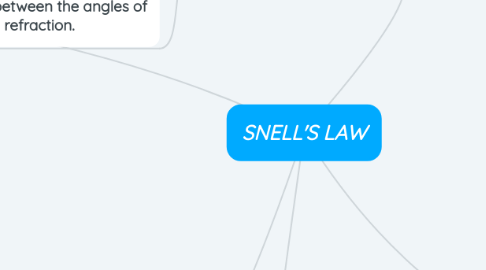
1. Snell's law is used to determine the direction of light rays through refractive media with varying indices of refraction. The indices of refraction of the media, labeled n1, n2 and so on, are used to represent the factor by which a light ray's speed decreases when traveling through a refractive medium, such as glass or water, as opposed to its velocity in a vacuum. As light passes the border between media, depending upon the relative refractive indices of the two media, the light will either be refracted to a lesser angle, or a greater one. These angles are measured with respect to the normal line, represented perpendicular to the boundary. In the case of light traveling from air into water, light would be refracted towards the normal line, because the light is slowed down in water; light traveling from water to air would refract away from the normal line. Refraction between two surfaces is also referred to as reversible because if all conditions were identical, the angles would be the same for light propagating in the opposite direction. Snell's law is generally true only for isotropic or specular media (such as glass). In anisotropic media such as some crystals, birefringence may split the refracted ray into two rays, the ordinary or o-ray which follows Snell's law, and the other extraordinary or e-ray which may not be co-planar with the incident ray. When the light or other wave involved is monochromatic, that is, of a single frequency, Snell's law can also be expressed in terms of a ratio of wavelengths in the two media, λ1 and λ2: sinθ1/sinθ2=v1/v2=λ1/λ2
2. n1sin(i) = n2sin(r)
2.1. Ray tracing - compute the ∠ of incidence or refraction, & in experimental optics to find the n of a material; Metamaterials - allow light to be bent "backward" (-∠, -n, -∠r).
2.2. Relationship between the angles of incidence and refraction.
3. HISTORY
3.1. PTOLEMY and ALHAZEN
3.1.1. PTOLEMY: Greek in Egypt; Relationship: refraction angles, inaccurate - big angles; Confident - 'accurate empirical law'. ALZAHEN: Closer - discovering the law of refraction.
3.2. SNELLIUS AND SAHL
3.2.1. WILLEBORD SNELLIUS: Namesake of the law. IBN SAHL: Described accurately; 'On Burning Mirrors and Lenses' - Derived lens shapes (focus light w/ no geometric aberrations).
3.3. HARRIOT, DESCARTES, DE FERMAT
3.3.1. THOMAS HARRIOT: Rediscovered the law in 1602; Results - not published. RENE DESCARTES: Independently derived the law; Dioptrics - Heuristic momentum conservation arguments in terms of sines; Assumed C* = ∞, denser medium = > C. PIERRE DE FERMAT: Rejected Descarte's solution; Same solution - principle of least time; Fermat supported the opposing assumptions; Utilized 'adequality'.
3.4. APPOLONIUS AND PAPPUS
3.4.1. APOLLONIUS OF PERGA & PAPPUS OF ALEXANDRIA: Worked on a problem; Showed loci = conics (When '—'* ≠ ||).
3.5. VOSSIUS
3.6. HUYGENS
3.6.1. ISAAC VOSSIUS: Said Descartes saw Snell's paper & concocted his own proof; Fermat & Huygens repeated this accusation.
3.6.2. CHRISTIAAN HUYGENS: Traite de la Lumiere - showed how Snell's law of sines could be explained by using 'Huygens–Fresnel principle'.
